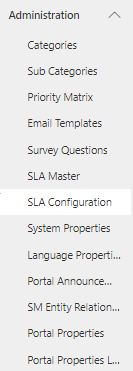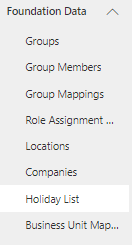SLA Configuration
The "SLA Configuration" table is a vital component within an IT Service Management (ITSM) system. It helps automate the process of creating Service Level Agreement (SLA) tasks based on predefined criteria such as priority, category, subcategory, and module.
Create an SLA Incident Configurations Record
- Navigate to SLA Configurations Tables. Administration > SLA Configuration.

- Click on the New button. The SLA Configurations form is displayed. On the form, fill in the fields.

| Field | Description |
|---|---|
| SLA Name | Specify the SLA name that links to “SLA Master” table associated with the same name |
| Priority | This field defines the importance level of the task, usually categorized as high, medium, or low. |
| Category | Grouping tasks into broader classifications based on their nature or type, like hardware, software, network, etc. |
| Subcategory | Offers further classification within a category, providing more specific details about the task |
| Module | Specifies the area responsible for managing the task, such as Incident Management, Problem Management etc. |
Holiday List
The use of a holiday list table in an SLA (Service Level Agreement) is to ensure that service level commitments are accurately maintained even on holidays. This table typically includes three fields: Name, Date, and Time zone.
- Navigate to SLA Configurations Tables. Foundation Data > Holiday List.

- Click on the New button. The form will be displayed. On the form, fill in the fields.

| Fields | Description |
|---|---|
| Name | This field define the the name of the holiday. For example, "Christmas," "New Year's Day," "Independence Day," etc. |
| Date | This is the specific date when the holiday occurs. For example, December 25th for Christmas, January 1st for New Year's Day, and so on |
| Timezone | Represents the timezone in which the holiday is observed. |
The holiday list table is essential in SLA calculations because it ensures that service level commitments remain accurate, even when holidays are involved. Let's break it down with an example:
Imagine an incident is created today, and it needs to be resolved within 24 hours according to the SLA. However, tomorrow is a holiday in the user's timezone. Without considering the holiday, the system might incorrectly calculate that the incident needs to be resolved by tomorrow, which is not feasible because it's a holiday.
Here's how the holiday list table comes into play:
- Incident Creation: The incident is created today.
- SLA Calculation: The system checks the SLA, which specifies a 24-hour resolution time. However, before calculating the deadline, it consults the holiday list table.
- Holiday Check: The system checks if tomorrow is a holiday in the user's timezone by referencing the holiday list table.
- Adjustment for Holiday: Since tomorrow is indeed a holiday, the system adjusts the calculation accordingly. It adds an extra day to the resolution time because the holiday should not count towards the SLA deadline.
- SLA Breach: With the holiday adjustment, the SLA deadline is extended by one day. This ensures fairness and accuracy in the SLA calculation. If the incident is not resolved by the adjusted deadline, it will breach the SLA.
So, by using the holiday list table, the system can accurately calculate SLA deadlines, accounting for holidays and timezone differences. This ensures that service level commitments are realistic and achievable, even in situations involving holidays.